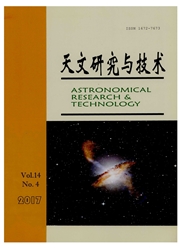

 中文摘要:
中文摘要:
我国的大视场光学瞬变源巡天设备地基广角相机阵每2.5 min机器初步筛选出近千个瞬变源候选体,这些瞬变源候选体可能为超新星、变星、移动天体或者是噪声等。为进一步对瞬变源候选体进行管理和详细地筛选与认证,提出了基于网络开发框架的Django平台实现后台数据库管理和前端网页交互展示功能的光学瞬变源认证系统的设计方案。通过研究,本方案主要具备对瞬变源候选体的管理;光变曲线处理与展示;与已知多个类型天体星表的交叉进行分类;同时提供人机交互的人工认证界面接口等功能。得益于Django框架的优秀特性,系统无需额外的开发,即可提供良好的命令方式交互接口,方便科学家通过Django的接口对数据库进行面向对象的操作。通过将系统应用于我国已建成的迷你地基广角相机阵的观测数据测试,结果表明系统能将瞬变源候选体进行正确的分类与认证,为科学家对瞬变源候选体的后期认证提供了丰富的信息和方便实用的操作工具。同时,系统对于其它类似的瞬变源巡天项目也具有同样的实用意义。
 英文摘要:
英文摘要:
Ground Wide Angle Camera( GWAC) will initially select thousands of transient candidates in every 2. 5 minutes. These candidates may be supernova,variable stars,moving objects,or noise. To identify and manage these candidates,we design and develop an optical transient identification system based on the web framework Django. This system will implement the database management system in the backend and web interactive display in the frontend. The system mainly includes the following functions: transient candidates management,light curve processing and display,crosscheck with multiple known celestial catalogs and interactive identification interface for the scientists. Due to Django's excellent characteristics,this system can provide a good command mode interactive interface,which makes the scientists operate the database in an object-oriented manner without any extra-developed codes. The system has been tested by observation data from the Mini-GWAC. The test indicates that transient candidates can be classified and identified correctly. It is a useful tool for astronomers to identify transient candidates with its preliminary identification and abundant information from automatically processing. This program can be used for other similar transient surveys in practice.
 同期刊论文项目
同期刊论文项目
 同项目期刊论文
同项目期刊论文
 Quiescent Luminous Red Galaxies (LRGs) as CosmicChronometers: on the Significance of the Mass and En
Quiescent Luminous Red Galaxies (LRGs) as CosmicChronometers: on the Significance of the Mass and En 期刊信息
期刊信息
